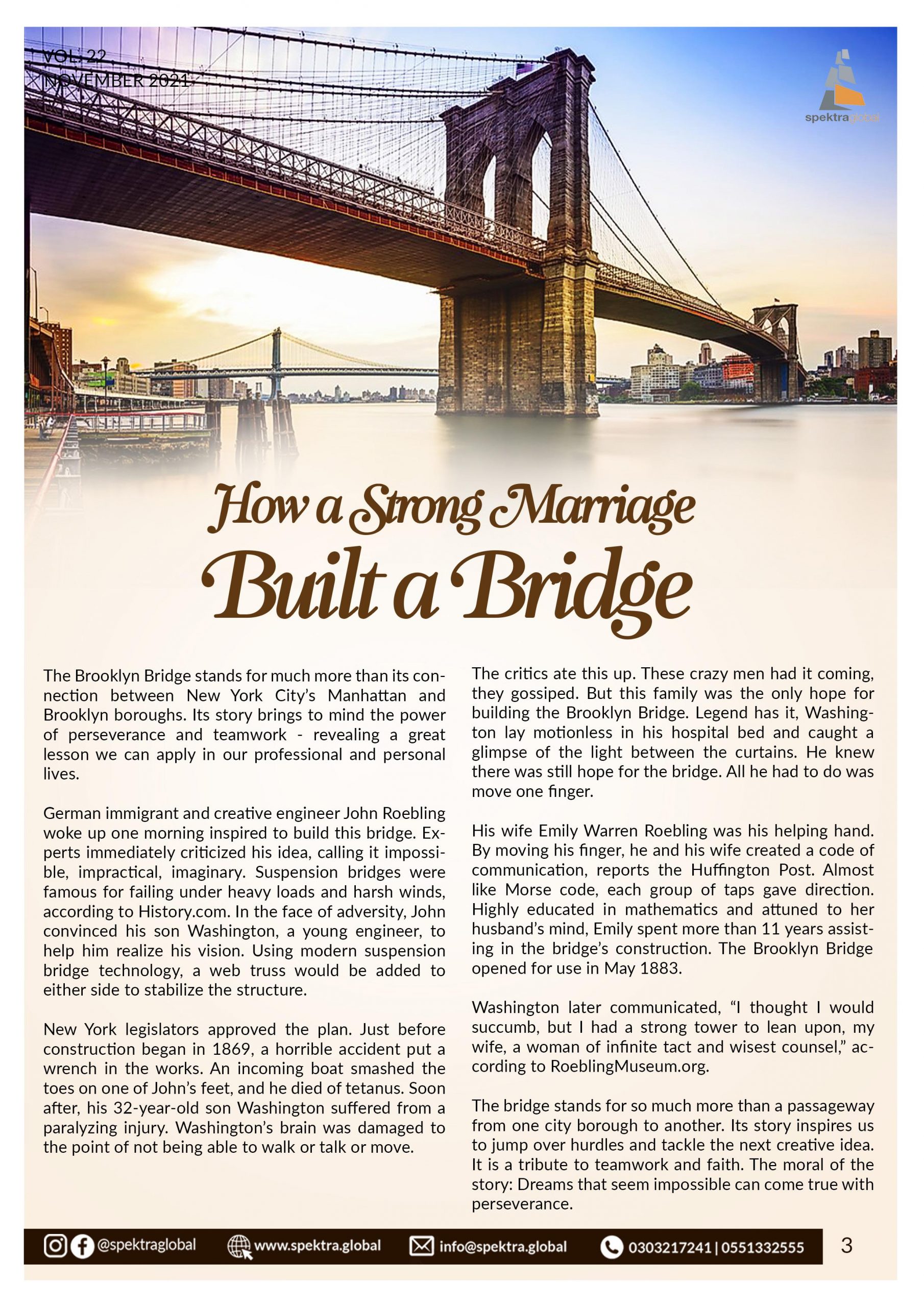
How A Strong Marriage Built A Bridge
The Brooklyn Bridge stands for much more than its connection between New York City’s Manhattan and Brooklyn boroughs. Its story brings to mind the power of perseverance and teamwork - revealing a great lesson we can apply in our professional and personal lives.
German immigrant and creative engineer John Roebling woke up one morning inspired to build this bridge. Experts immediately criticized his idea, calling it impossible, impractical, imaginary. Suspension bridges were famous for failing under heavy loads and harsh winds, according to History.com. In the face of adversity, John convinced his son Washington, a young engineer, to help him realize his vision. Using modern suspension bridge technology, a web truss would be added to either side to stabilize the structure.
New York legislators approved the plan. Just before construction began in 1869, a horrible accident put a wrench in the works. An incoming boat smashed the toes on one of John’s feet, and he died of tetanus. Soon after, his 32-year-old son Washington suffered from a paralyzing injury. Washington’s brain was damaged to the point of not being able to walk or talk or move.
The critics ate this up. These crazy men had it coming, they gossiped. But this family was the only hope for building the Brooklyn Bridge. Legend has it, Washington lay motionless in his hospital bed and caught a glimpse of the light between the curtains. He knew there was still hope for the bridge. All he had to do was move one finger.
His wife Emily Warren Roebling was his helping hand. By moving his finger, he and his wife created a code of communication, reports the Huffington Post. Almost like Morse code, each group of taps gave direction. Highly educated in mathematics and attuned to her husband’s mind, Emily spent more than 11 years assisting in the bridge’s construction. The Brooklyn Bridge opened for use in May 1883.
Washington later communicated, “I thought I would succumb, but I had a strong tower to lean upon, my wife, a woman of infinite tact and wisest counsel,” according to RoeblingMuseum.org.
The bridge stands for so much more than a passageway from one city borough to another. Its story inspires us to jump over hurdles and tackle the next creative idea. It is a tribute to teamwork and faith. The moral of the story: Dreams that seem impossible can come true with perseverance.
German immigrant and creative engineer John Roebling woke up one morning inspired to build this bridge. Experts immediately criticized his idea, calling it impossible, impractical, imaginary. Suspension bridges were famous for failing under heavy loads and harsh winds, according to History.com. In the face of adversity, John convinced his son Washington, a young engineer, to help him realize his vision. Using modern suspension bridge technology, a web truss would be added to either side to stabilize the structure.
New York legislators approved the plan. Just before construction began in 1869, a horrible accident put a wrench in the works. An incoming boat smashed the toes on one of John’s feet, and he died of tetanus. Soon after, his 32-year-old son Washington suffered from a paralyzing injury. Washington’s brain was damaged to the point of not being able to walk or talk or move.
The critics ate this up. These crazy men had it coming, they gossiped. But this family was the only hope for building the Brooklyn Bridge. Legend has it, Washington lay motionless in his hospital bed and caught a glimpse of the light between the curtains. He knew there was still hope for the bridge. All he had to do was move one finger.
His wife Emily Warren Roebling was his helping hand. By moving his finger, he and his wife created a code of communication, reports the Huffington Post. Almost like Morse code, each group of taps gave direction. Highly educated in mathematics and attuned to her husband’s mind, Emily spent more than 11 years assisting in the bridge’s construction. The Brooklyn Bridge opened for use in May 1883.
Washington later communicated, “I thought I would succumb, but I had a strong tower to lean upon, my wife, a woman of infinite tact and wisest counsel,” according to RoeblingMuseum.org.
The bridge stands for so much more than a passageway from one city borough to another. Its story inspires us to jump over hurdles and tackle the next creative idea. It is a tribute to teamwork and faith. The moral of the story: Dreams that seem impossible can come true with perseverance.





